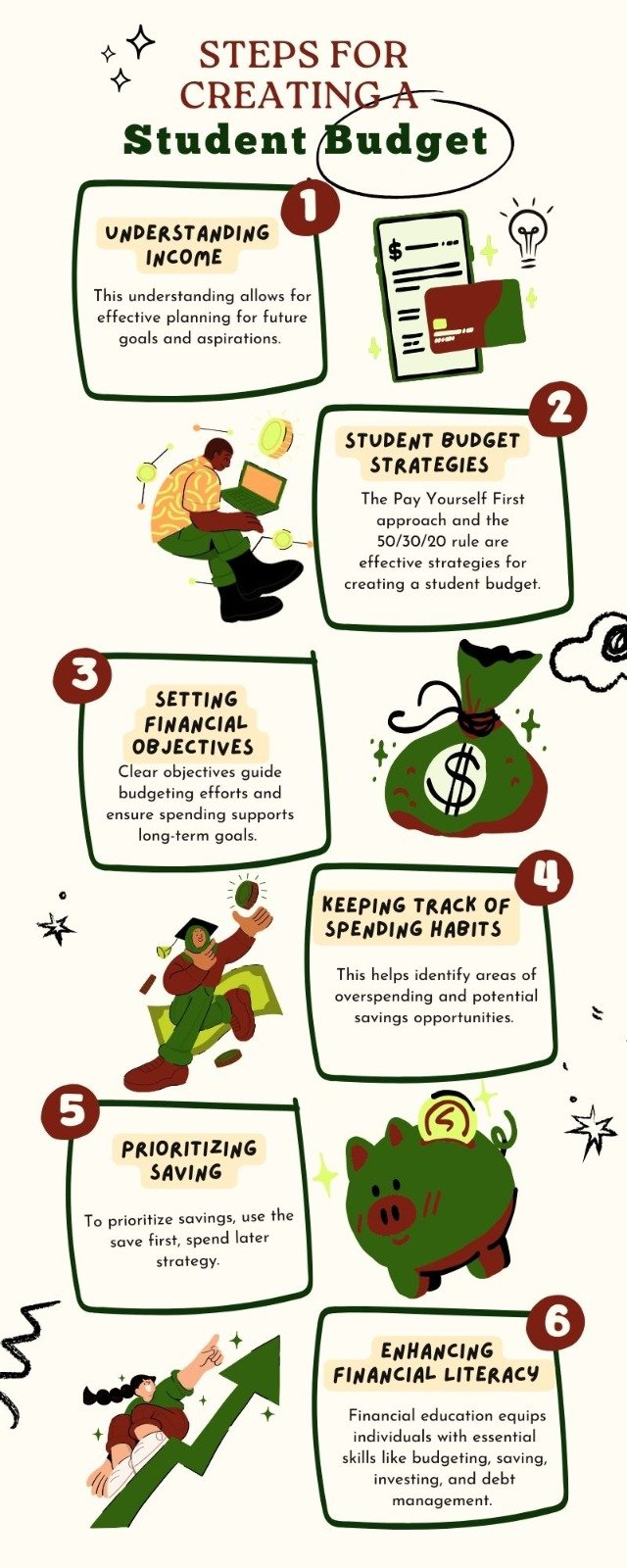A student budget is essential for achieving financial success, allowing students to establish financial goals, manage their expenses, and maintain control over their finances. It includes understanding the sources of income, selecting a budgeting strategy, setting financial objectives, tracking spending habits, remaining adaptable, and emphasizing the importance of saving.
In Short
Student Budget
Creating a student budget is critical for various reasons. To begin, it’s important to set goals and make decisions; perhaps you’re interested in that new game or gadget. A budget can help you save money without feeling pressed for cash. Understanding the distinction between needs and wants is crucial for wise spending.
Mastering this early on provides the groundwork for financial success, and your future self will appreciate it! Today’s youngsters are increasingly aware of the importance of budgeting and its function in modern financial management.
Budgeting enhances appreciation for money, providing a sense of accomplishment and control over expenses like concert tickets or shopping. It also helps you comprehend and work toward major goals such as purchasing a car or saving for college.
Create a Simple Budget for Students
Making a simple budget as a student is a positive step toward financial freedom. Begin by recognizing your revenue sources, whether they are allowances or part-time jobs, as this creates the framework for sound financial management. Next, divide your expenses into three categories: savings, necessities like gasoline or phone bills, and discretionary spending like gym memberships or dining out.
Setting specific financial goals, such as saving for college or purchasing a new technology, provides guidance and inspiration. Stay diligent by evaluating your spending habits, changing your budget as appropriate, adopting a minimalist attitude toward spending, and refusing peer pressure.

Why is money key? Money is necessary for happiness and progress. Food, housing, entertainment, and emergencies require financial literacy. We control our lives with financial independence, but it takes careful saving and investing. Read more…
Simple Steps to Create a Student Budget
Step 1: Understanding Your Income
Starting a student budget requires a thorough comprehension of your income sources. Understanding your income, whether from allowances or part-time jobs, is crucial for making informed financial decisions.
This understanding enables you to make more informed spending and saving decisions, ensuring that your budget reflects your financial realities. Understanding your total income allows you to effectively plan for your future goals and aspirations.
Step 2: Student Budget Strategies
There are various effective strategies available for creating a student budget. The Pay Yourself First approach is a strategy where individuals save a portion of their income before allocating it to other expenses.
The 50/30/20 rule is a financial strategy that suggests allocating 50% of your income for necessities, 30% for desires, and the remaining 20% for savings.
Both strategies provide distinct advantages, enabling you to customize your budgeting strategy to align with your financial objectives and priorities.
Step 3: Setting Financial Goals
The most important thing to keep in mind while making a student budget is to establish measurable objectives that parallel your dreams. Having a specific end goal in mind may help direct and encourage your budgeting efforts, whether it’s saving for college, a new device, or establishing a small company.
To make sure your spending supports your long-term goals, it’s helpful to have clear objectives. With these objectives in mind, you may make smart financial decisions that get you closer to your aspirations without breaking your student budget.
Step 4: Identify Income Sources
Your money as a student might come from a variety of sources, such as grants, part-time work, or even random donations. Retail, childcare, and freelancing are common student occupations that typically pay around $10.03 per hour, however this may vary greatly based on your interests and abilities.
If you want to learn how to handle your student budget well, it helps to first understand where your money is coming from. You can’t make good financial judgments or practice prudent money management without first understanding your revenue sources.
Step 5: Establishing Budget Categories
When creating your student budget, it’s crucial to categorize your expenses effectively. Consider allocating funds for savings, aiming for goals like college expenses or retirement planning.
The next stage is to identify essential expenses such as transportation and monthly payments that are required for everyday living. Finally, allocate a portion of your budget for discretionary expenses. Breaking down expenses into categories helps you understand your financial goals and priorities, allowing you to prioritize your spending accordingly.
Step 6: Monitor Your Spending Habits
Regularly tracking your expenses provides valuable insights into your spending patterns and behaviors. Using a meticulous financial monitoring method can help you identify areas of overspending and potential savings opportunities. This understanding allows you to make informed decisions about your financial priorities and adjust your budget accordingly.
Tracking your spending habits promotes financial mindfulness and helps you develop responsible money-management skills. Maintaining a financial record via budgeting applications, spreadsheets, or manual techniques ensures financial management and keeps you on track to achieve your financial goals.
Step 7: Flexibility in Budgeting
To achieve financial goals, it’s crucial to adapt your budget as needed. This involves reallocating funds, revising savings goals, and exploring new income sources. By being open to adjustments, you can ensure your budget remains realistic and effective, enabling you to navigate challenges and seize opportunities while maintaining control over your finances.
Step 8: Prioritize Saving
When creating your student budget, prioritize savings by following the save first, spend later strategy. This means setting aside a portion of your income for savings before allocating it to other expenses.
Making saving a priority ensures you’ll contribute to your savings account on a regular basis, thus building your financial reserves. This practice not only encourages proactive money management but also supports disciplined saving behavior.
Prioritizing saving helps build a strong financial foundation for long-term goals like education, travel, or emergency funds. Incorporating saving into your budgeting routine can lead to financial security and success.
Step 9: Minimalist Spending
Minimalism is a philosophy that prioritizes quality above quantity and promotes attentiveness in purchasing decisions. Focus on acquiring items with genuine value and significance to you rather than accumulating material possessions for accumulation purposes. Choose items that align with your needs and priorities, considering the long-term utility and satisfaction gained from each purchase.
A minimalist approach can help you manage your finances, reduce clutter, and allocate resources for essential matters. This method of spending intentionally encourages a deeper appreciation for one’s possessions, thereby promoting a more sustainable and fulfilling lifestyle.
Step 10: Gain Insight into Your Spending Habits
Take the initiative to gather data on your expenditures and meticulously track every dollar spent. To effectively manage your finances, start by keeping track of your expenses for at least a week, preferably a month, to gain a comprehensive understanding of your financial situation. Analyzing this data can help identify areas of excessive spending, recurring expenses, and financial behavior patterns. This information is crucial for creating a budget that is realistic and aligns with your financial objectives and priorities.
Understanding your current spending habits helps you make informed decisions about resource allocation, identify savings opportunities, and prepare you for more effective and mindful money management in the future.
Step 11: Define Your Financial Goals
To achieve financial goals, it’s crucial to define short-term and long-term objectives that are specific to your aspirations and priorities. These goals can range from saving for college tuition to purchasing a car, and they guide your financial decisions and actions.
Consistently setting aside a small amount can lead to significant growth over time. By committing to your goals and being consistent in your savings efforts, you may make steady progress toward them. Regularly examine your goals to ensure they are still relevant, and update them as appropriate to reflect changes in your circumstances or aspirations. By focusing on and achieving financial goals, you can establish a solid foundation for a secure and prosperous future.
Step 12: Enhance Your Financial Literacy
Take steps now to improve your financial literacy and empower yourself with the knowledge required to make sound decisions. Financial education equips individuals with essential skills like budgeting, saving, investing, and debt management, enabling them to confidently navigate the complexities of personal finance.
Step 13: Embrace Learning from Mistakes
Making mistakes is a natural part of the learning process, but what is truly important is the ability to learn from them. Viewing mistakes as opportunities for growth and improvement is a more effective approach than dwelling on them. Reflect on past mistakes, identify areas for improvement, and utilize these insights to enhance your budgeting strategy.
Learning from your failures allows you to gain a better knowledge of your financial habits and create more effective money management tactics. Mistakes in budgeting can lead to improved financial literacy, whether it’s overspending in certain categories or underestimating expenses.
Step 14: Stay Vigilant and Adapt
To maintain a successful budget, it’s crucial to be vigilant and adaptable. Monitor your finances regularly, making adjustments as circumstances change. Ensure your spending and income align with your budgetary goals, and be aware of any changes, such as expenses or income sources.
To maintain financial stability, be flexible and proactive in adjusting your budget. This includes reallocating funds, revising savings goals, and exploring new income opportunities. Embrace change as an opportunity for growth and refinement, and prioritize smart money management practices for long-term success. This will help you maintain control over your budget and achieve your financial objectives.
A personal budget is essential for financial goals and retirement security. Financial goals, income and expense analysis, and learning from mistakes are involved. This helpful rule divides income into three categories: 50% for needs, 30% for wants, and 20% for savings and investments. Read more…
Final Thoughts
Understanding income sources and expenditure destinations allows for informed choices and a solid financial future. A simple budget is essential for prioritizing goals, tracking spending, and allocating resources effectively. Careful planning and adherence to budgeting principles cultivate healthy financial habits. The key to financial success lies in being mindful of financial decisions and disciplined in money management. By incorporating these principles into daily life, one can pave the way for a brighter future.
FAQ
What are the 4 steps in the student budget?
The four steps to create a student budget are as follows: First, identify your sources of income, such as allowances, part-time work, or scholarships. Second, identify all of your expenses, including tuition, rent, groceries, and entertainment. The third step involves calculating total revenue and deducting all costs to determine discretionary income. Finally, set aside this discretionary income for savings, debt repayment, and other financial goals, modifying as needed to ensure financial stability.
What is the 50 30 20 rule?
The 50/30/20 rule is a budgeting strategy that recommends dividing your after-tax income into three categories: 50% for essentials, 30% for wants, and 20% for savings or debt reduction. Rent, groceries, utilities, and transportation are examples of necessities, but wants include discretionary spending on dining out, entertainment, and shopping. The remaining 20% goes towards savings, emergency funds, or debt repayment. This rule gives a straightforward foundation for managing your finances and establishing a healthy balance of spending, saving, and debt management.













Leave a Reply